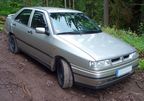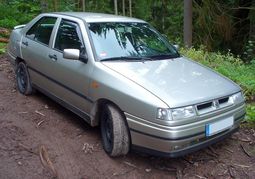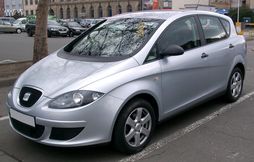The History Of SEAT Toledo

The SEAT Toledo is an automobile built and marketed by Spanish automaker SEAT, a division of the Volkswagen Group (Volkswagen AG). The Toledo name was first introduced to the SEAT line-up in 1991, and the third generation was introduced in late 2004.
The Toledo was the first SEAT developed entirely under VW leadership. The first generation was a five-door liftback built on the Volkswagen Golf Mk2 Volkswagen Group A2 platform chassis, with boot similar in shape and size to the Volkswagen Bora's but with the advantage of a tailgate. As saloon versions of small family cars were rare in Europe, it was sometimes considered a large family car due to its overall length and boot size, despite having smaller rear leg room, and pricing closer to small family cars.
The Toledo initially featured underpowered engines compared to the Ibiza and Málaga's System Porsche units, such as a base 1.6L 75PS (55kW) petrol engine and a GT version using the 2.0L 115PS (85kW) engine. Later the Toledo would see the addition of more powerful versions, including a 150PS (110kW) 2.0 GTI 16V and 110PS (81kW) 1.9 TDI which, like many diesels built since 1996 by the Volkswagen Group, it is advertised as capable of running on both mineral diesel and biodiesel.
This version of the Toledo is built by Chinese car manufacturer Chery and sold under the names Chery Amulet, Cowin, Windcloud and Flagcloud. Chery acquired the chassis of the 1993 Toledo from a Mexican dealership after authorization from SEAT. Chery Cowin ,which is based on Seat Toledo, already has an authorization to market it in Europe along with Russia and South America.
Engine choices
The second generation was introduced in 1998. It was more rounded than the previously boxy shape. It had a much more fluid design, although both were products of Giorgetto Giugiaro's Italdesign studio.
It shared components with both its Škoda and Volkswagen brothers (the Octavia and the Bora) yet is supposedly the sportiest out of the three, and sport details have been added, such as completely translucent headlights not often seen in cars at that time, and a more rounded dashboard with white dials.
It was built on the Volkswagen Golf Mk4 platform, which meant stiff springs to support the load of the large 500 litre boot. The early models were built at the Audi/ VW plant in Belgium with much improved build quality, although the Toledo was still presented as an economic alternative to the lower level of the D segment, and included in the basic price a high level of equipment. One of the features most associated with the Spanish model, the tailgate was removed in favour of a more traditional saloon boot opening. The following year, the Toledo would be used as the base for a proper hatchback, the SEAT León.
Base model was now a crossflow 1.6-litre 100PS (74kW) petrol engine, followed by a 1.8-litre 20-valve 125PS (98kW) unit, while the top of the line was represented by the 2.3-litre 150PS (110kW) V5 engine. Diesel versions used the 1.9 TDI engine, with a variable geometry turbocharger, offered initially with power outputs of 90PS (66kW) or 110PS (81kW). In 2001, the V5 engine was uprated with a 20v head boosting power to 170PS (167.7hp/ 125kW). Later in the series, the 1.8-litre 20-valve Toledo received a turbocharger, capable of delivering 180PS (132kW), and a later evolution of the VW TDI engine, produced engines of 130PS (96kW) and 150PS (110kW). These three versions all featured a six-speed manual transmission. The 130 PS TDI also featured white dials instead of the standard black dials on the 110 & 150 PS TDI models.
The third generation was introduced in 2004, and it is completely different from the previous two. Abandoning the traditional "three-box" saloon format, the Toledo Mk3 has a very controversial design, penned by Walter de'Silva. It is now closer to a compact MPV with the Altea's front section, a high roof, and a rearend inspired in the Renault Vel Satis, paying homage to the original Toledo's hatchback/ sedan rear.
All pretense of a sporty identity was thrown out, in favour of a more upscale and alternative image. A large 500L DIN boot is its most interesting feature. Under the bodywork, the SEAT Toledo uses the same underpinnings as the Volkswagen Golf Mk5. All engines are identical to other Volkswagen Group units, with petrol engines ranging from 102 to 150PS (75 to 110kW) and diesel engines from 105 to 140PS (77 to 103kW).
Updates include the arrival of a 170PS (125kW) TDI engine in 2006, as well as a Tiptronic gearbox in the 2.0 FSI model. A 1.8L turbocharged version of this engine became available in mid 2007.
Engine choices
The engines used are the same as for many other cars in the Volkswagen Group.
- only for some export markets
- with diesel particulate filter
In many European markets, the third-generation Toledo has not been a strong seller, its chances of success hardly helped by its unusual styling. SEAT will release in 2009 an Audi A4 Mk3-based large family car, with saloon and estate bodystyles. However, the carmaker announced in June 2008 that it will be named Exeo instead of Toledo as previously rumoured.The Exeo will not be a replacement for the Toledo according to the company.
From Wikipedia, the free encyclopedia
More About SEAT Toledo



|